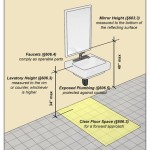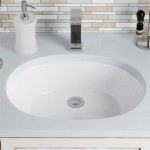How to Replace a Bathroom Pedestal Sink
Replacing a bathroom pedestal sink can significantly update the look and functionality of a bathroom. While a seemingly daunting task, completing this project is well within the capabilities of many homeowners with basic plumbing knowledge and the right tools. Careful planning, preparation, and adherence to safety protocols are essential for a successful installation. This article details the steps involved in safely removing an old pedestal sink and installing a new one. It is crucial to consult local building codes and regulations before undertaking any plumbing work, and if unsure, to engage a licensed plumber.
Prior to beginning, gather all necessary tools and materials. This might include a new pedestal sink (with all included hardware), adjustable wrenches, a basin wrench (also known as a sink wrench), a pipe wrench, a screwdriver set (both Phillips head and flathead), channel-lock pliers, a level, a measuring tape, plumber's putty, Teflon tape (plumber's tape), silicone caulk, safety glasses, gloves, a bucket, rags or towels, and a utility knife. Depending on the condition of the existing plumbing, new supply lines and shut-off valves might also be required.
Safety is paramount. Before starting any work, turn off the water supply to the sink. Locate the shut-off valves, typically found beneath the sink. If these valves are absent or malfunctioning, the main water supply to the house needs to be turned off. Once the water is shut off, open the faucet to relieve any remaining pressure in the lines. Place a bucket underneath the sink to catch any residual water that might be present in the pipes. Wear safety glasses to protect the eyes from debris and gloves to protect the hands.
Removing the Existing Pedestal Sink
The first step is disconnecting the water supply lines. Using adjustable wrenches, carefully disconnect the supply lines from the faucet tailpieces. Be prepared for a small amount of water to leak out, even after turning off the water supply. Use rags or towels to absorb any spills. Inspect the supply lines for signs of corrosion or damage. If they are old or in poor condition, they should be replaced with new ones during the installation of the new sink.
Next, disconnect the drainpipe. Place a bucket underneath the P-trap (the curved section of the drainpipe) to catch any water. Loosen the slip nuts connecting the P-trap to the drain tailpiece and the drainpipe in the wall using channel-lock pliers. If the nuts are corroded or difficult to loosen, penetrating oil might be helpful. Once the nuts are loose, carefully remove the P-trap and the drain tailpiece. Inspect the drainpipe for any blockages or corrosion. Clean the inside of the drainpipe with a wire brush to remove any buildup.
With the water and drain lines disconnected, the next step is to detach the sink basin from the pedestal and the wall. Most pedestal sinks are attached to the wall with mounting bolts or screws. Locate these fasteners and remove them with a screwdriver or wrench. If the fasteners are rusted or stuck, penetrating oil can be used to loosen them. Once the fasteners are removed, gently lift the sink basin off the pedestal. It is likely that the sink is sealed to the wall with a bead of caulk. Use a utility knife to carefully cut through the caulk along the edge of the sink where it meets the wall.
With the sink basin detached from the wall, carefully lift it off the pedestal. Pedestal sinks can be heavy, so it is essential to have assistance if needed. Once the sink basin is removed, the pedestal can be lifted away from the wall. Clean the area behind the sink and around the plumbing connections. Remove any old caulk or adhesive from the wall surface using a scraper or putty knife. Inspect the drainpipe and water supply pipes for any leaks or damage. Repair any issues before proceeding with the installation of the new sink.
Preparing for the New Sink Installation
Before installing the new pedestal sink, it is important to prepare the area and ensure that the plumbing is in good working order. This includes inspecting the shut-off valves for leaks and functionality. If the valves are old or corroded, they should be replaced. New shut-off valves will ensure a reliable water supply and prevent future leaks. Clean the drainpipe and water supply pipes thoroughly to remove any debris or corrosion. If necessary, use a wire brush to clean the inside of the drainpipe.
Dry-fit the new pedestal sink to ensure that it fits properly and that the plumbing connections align correctly. Place the pedestal in the desired location and then position the sink basin on top. Check the alignment of the drain tailpiece with the drainpipe in the wall. Also, check the alignment of the faucet holes with the water supply lines. If any adjustments are necessary, make them before proceeding with the installation. This step will help identify any potential problems and ensure a smooth installation process.
Install the faucet and drain assembly on the sink basin before mounting it to the pedestal and wall. This is much easier to do while the sink basin is accessible. Follow the manufacturer's instructions for installing the faucet and drain assembly. Be sure to use plumber's putty around the drain flange to create a watertight seal. Wrap Teflon tape around the threads of the drain tailpiece and faucet tailpieces to prevent leaks. Tighten all connections securely, but avoid over-tightening, which can damage the fixtures.
Installing the New Pedestal Sink
With the faucet and drain assembly installed, the sink basin can be mounted to the pedestal. Position the pedestal in the desired location and then carefully lift the sink basin onto the pedestal. Align the mounting holes in the sink basin with the mounting brackets on the pedestal. Secure the sink basin to the pedestal using the provided hardware. Tighten the fasteners securely, but avoid over-tightening. Use a level to ensure that the sink basin is level before fully tightening the fasteners.
Next, attach the sink basin to the wall using mounting bolts or screws. Locate the studs in the wall and mark the locations of the mounting holes. Drill pilot holes into the studs if necessary. Attach the sink basin to the wall using the provided hardware. Tighten the fasteners securely, but avoid over-tightening. Use a level to ensure that the sink basin is level before fully tightening the fasteners. Cover the fasteners with decorative caps if provided.
Connect the water supply lines to the faucet tailpieces. Wrap Teflon tape around the threads of the faucet tailpieces. Attach the supply lines to the faucet tailpieces using adjustable wrenches. Tighten the connections securely, but avoid over-tightening. Turn on the water supply slowly and check for leaks. If any leaks are detected, tighten the connections further or replace the Teflon tape. Ensure that the shut-off valves are functioning properly.
Connect the drain tailpiece to the drainpipe in the wall using the P-trap. Assemble the P-trap and slip the nuts onto the drain tailpiece and the drainpipe. Tighten the slip nuts by hand and then use channel-lock pliers to tighten them further. Be careful not to over-tighten the nuts, as this can damage the plastic pipes. Check for leaks by running water into the sink. If any leaks are detected, tighten the connections further or replace the slip washers.
Apply a bead of silicone caulk around the edge of the sink basin where it meets the wall. This will create a watertight seal and prevent water from seeping behind the sink. Use a caulk gun to apply the caulk evenly and smoothly. Use a wet finger or a caulk smoothing tool to create a clean, professional-looking caulk line. Allow the caulk to dry completely before using the sink.
After installation, thoroughly inspect all connections for leaks. Run water in the sink and check the drain for proper flow. Ensure that the faucet is functioning correctly and that there are no drips or leaks. Clean the sink and surrounding area to remove any debris or fingerprints. Dispose of any old materials and packaging properly.

Here S How Install A Bathroom Pedestal Sink

How To Remove A Pedestal Sink Diy By Real Regular Homeowner

How To Replace A Pedestal Sink Ask This Old House

How To Remove A Pedestal Sink And Install Vanity

How To Replace A Pedestal Sink With Vanity

How To Install A Pedestal Sink The Home Depot

How To Install A Pedestal Sink W Detailed Pictures Bestlife52

Our Home From Scratch

Here S How Install A Bathroom Pedestal Sink

Your Ultimate Guide To Removing A Pedestal Sink
Related Posts







